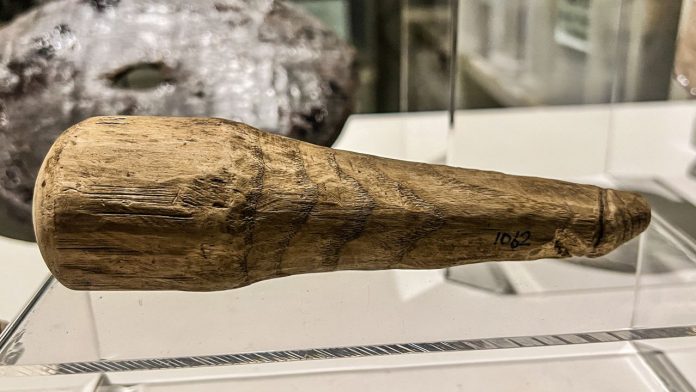Photo from the University College Dublin and The Vindolanda Trust
A phallic wooden object which was discovered in 1992, and dated nearly 2,000 years old, is now being considered in a study as the only Roman artifact of a sex toy known to exist.
The object, carved from an ash tree, was found at the Roman Fort of Vindolanda, near the explicit Roman graffiti of Hadrian’s Wall, which once was the fort of the Roman Empire’s northwest frontier, in northern England, according to CNN.
Initially, the find was misidentified as a darning tool, because it lay alongside remnants of clothing, accessories and shoes. Upon further inspection, however, researchers have considered other possible functions for the disembodied penis shape.
A team from University College Dublin and Newcastle University have just this week published a study in the journal Antiquity, which suggests that the 160 millimeters (6.3 inches) long wooden carving may have been used sexually, more likely for clitoral stimulation than for penetration.
“It very well could be a sex object and, if it is, it is the first example from the Roman world,” shares Rob Collins, a senior lecturer in archaeology at Newcastle University in the United Kingdom and coauthor of the study, according to CNN. “We shouldn’t be surprised by this. We know from Roman art and Roman literature that they used dildos, that they existed. But we haven’t found any examples archaeologically yet.”
One plausible reason sex toy remains are an uncommon archaeological find, according to the British researchers, is that ancient dildos were likely made from organic materials which degraded over time.
However, if the archaeological find is indeed a sex toy, researchers add that it may not always have been used exclusively for pleasure; the study shows that the object could have been used to cause pain.
“So, the other thing we have to be conscious of is that it would be easy to cast such an object as silly and frivolous and just about sexual gratification, but it could be a tool for perpetuating power imbalance and subjugation,” says Collins.
Alternatively, CNN explains that the item found could be altogether innocent, as “small, portable phallus objects were commonly found as pendants, probably to avert evil or bad luck, according to the study.”
Read the full CNN story here, CNET’s take here and the published archaeological study here.













